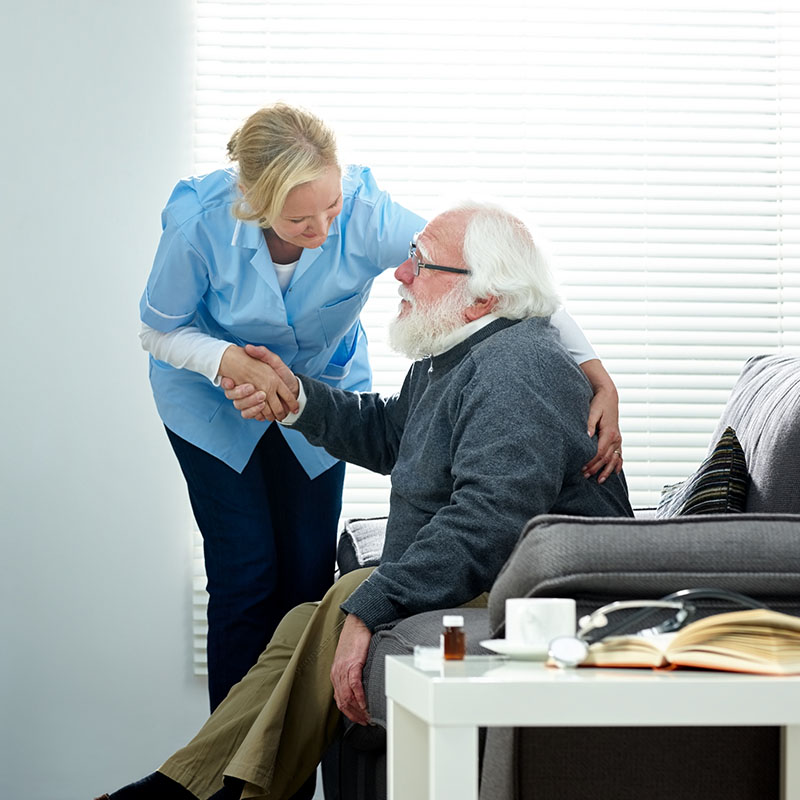Bedsores
Kansas City Bedsore Attorneys
Representing the Rights of the Elderly & Disabled
Also known as pressure ulcers or decubitus ulcers, bedsores are serious injuries to the skin and surrounding tissues caused by extended pressure on affected areas of the body. Elderly individuals and those with mobility issues require frequent repositioning to avoid bedsores. When nursing home staff and caregivers fail to take the proper steps to prevent or properly treat bedsores, they can be held responsible.
Our Kansas City bedsore attorneys have successfully represented numerous clients who have suffered devastating injuries and complications related to pressure ulcers. We also represent families who have lost loved ones due to nursing home abuse and neglect, leading to bedsores and other injuries.
If you or your loved one developed bedsores due to poor or negligent care in a long-term assisted living facility, reach out to our team at the Law Office of Tom Wagstaff Jr. for help. Learn how our firm can help you with your claim; call 816-708-0524 or contact us online to schedule a free consultation today.

What Are Bedsores?
Bedsores, or pressure ulcers, are wounds that occur on the skin and may cause damage to surrounding tissue. Bedsores are most common in people with limited mobility, as they result from prolonged pressure on the skin, often caused by lying or sitting in one position for an extended period of time. When left untreated, bedsores can advance to more serious stages.
The Four Stages of Bedsores Include:
- Stage 1: Stage 1 bedsores are the mildest stage. However, immediate treatment is still required to prevent stage 1 bedsores from progressing. At this stage, bedsores are characterized by red, blue, or purple-tinted skin that is often warm to the touch, as well as burning, pain, and itching.
- Stage 2: Stage 2 bedsores are slightly more advanced than stage 1 bedsores. At this stage, bedsores may appear as open scrapes or sores, or they may look like blisters. They are often accompanied by pain and discoloration of the skin.
- Stage 3: Like stage 2 bedsores, stage 3 bedsores typically appear as blisters, wounds, or scrapes. At this stage, the skin around the affected area will also have an indented, crater-like appearance caused by damage to the underlying tissue.
- Stage 4: Stage 4 bedsores are considered the most advanced type of bedsore. At this stage, the skin and surrounding area are severely damaged and bedsores will appear as a large, open wound. Stage 4 bedsores can also lead to bone, tendon, muscle, and joint damage, as well as an increased risk of serious or even fatal infection.
Warning Signs of Bedsores
People who are most at risk of bedsores include those who use wheelchairs, have limited mobility, or are bedridden. It is important that caregivers check individuals for warning signs and act appropriately when such signs are detected. Failing to address bedsores at an early stage can lead to progression, which puts the individual at risk of serious complications, health risks, and infections. Some of the most common warning signs of bedsores include:
One of the first signs of a developing bedsore is discomfort or pain in areas where pressure is frequently applied. This pain may be persistent or increase over time.
Redness in areas that bear weight or where the skin is in constant contact with a surface can indicate the beginning stages of a bedsore. This redness does not fade after relieving the pressure.
Swelling around a bony area or pressure point can be an indication of inflammation and the beginning of skin breakdown.
The temperature of the affected area may change, feeling unusually warm or cool compared to the rest of the body.
The area might be sensitive to touch, even with light pressure. This tenderness can be an early sign of skin damage and the development of a bedsore.
The affected area may become itchy, which can be an early sign of skin irritation or breakdown.
A burning sensation in a particular area of the skin can be a sign of tissue damage due to prolonged pressure.
The skin may become harder, softer, warmer, or cooler than the surrounding skin. The texture might also change, appearing more shiny or taut.
If a bedsore has progressed, it might start to ooze pus-like fluid, indicating an infection. This can be accompanied by an unpleasant odor.
What Causes Bedsores?
At the Law Office of Tom Wagstaff Jr., our team knows how to effectively prove these types of claims. Our Kansas City bedsore lawyers have the experience, resources, and willingness to take cases to trial whenever necessary. You can rely on our firm to fight tirelessly for every penny you are owed, along with the justice you deserve. Generally speaking, bedsores are caused by extended pressure on the skin. This is often the result of prolonged sitting and/or lying down. Elderly individuals and those with disabilities/mobility issues are at a heightened risk of developing bedsores, and nursing home staff and caregivers should respond accordingly. Here are the common causes:
Continuous pressure on any part of the body can limit blood flow to the tissues. This is most common in areas with little muscle or fat cushioning, such as the hips, tailbone, heels, and elbows. People who are bedridden or use a wheelchair are at higher risk.
Friction occurs when the skin rubs against clothing or bedding, making fragile skin more susceptible to injury. This can happen when a person changes position or is moved by caregivers.
Shear occurs when two surfaces move in opposite directions, such as when a person slides down in a bed or chair. This motion can cause the skin to stretch and tear the blood vessels, leading to tissue damage.
Excessive moisture from sweat, urine, or feces can weaken the skin and make it more vulnerable to damage. Incontinence or poor hygiene can exacerbate this problem.
Adequate nutrition and hydration are essential for maintaining healthy skin. Malnutrition and dehydration can impair skin integrity and slow the healing process, increasing the risk of bedsores.
Certain medical conditions, such as diabetes, vascular disease, and conditions affecting blood circulation, can increase the risk of developing bedsores. These conditions can impair blood flow and make the skin more susceptible to damage.
People with limited mobility, such as those who are paralyzed, in a coma, or recovering from surgery, are at a higher risk of developing bedsores. The inability to change positions frequently increases the likelihood of prolonged pressure on certain areas of the body.
Elderly individuals are at a higher risk for bedsores due to thinner skin, reduced elasticity, and decreased blood flow. Additionally, older adults are more likely to have conditions that limit their mobility and impair skin health.
Significant weight loss can reduce the amount of cushioning over bony areas, increasing the risk of pressure ulcers. This is common in individuals with chronic illnesses or those who are bedridden.
Smoking can decrease blood flow and reduce oxygen delivery to tissues, impairing the skin's ability to heal and increasing the risk of bedsores.
How Can Bedsores Be Prevented in a Nursing Home Setting?
In a nursing home setting, the prevention of bedsores (also known as pressure ulcers) involves several key measures. It’s important for nursing homes to have comprehensive protocols and policies in place to address the prevention of bedsores. By implementing these preventive strategies and ensuring a high standard of care, the risk of bedsores can be significantly reduced in a nursing home setting. Some strategies to prevent bedsores include:
- Regular Repositioning: Residents should be repositioned frequently to relieve pressure on specific areas of the body. This helps to promote circulation and prevent the development of bedsores.
- Adequate Nutrition and Hydration: Proper nutrition plays a crucial role in preventing bedsores. Residents should receive a well-balanced diet that includes sufficient protein, vitamins, and minerals to support healthy skin. Adequate hydration is also important to maintain skin health and prevent dryness.
- Skin Care and Hygiene: Regularly cleaning and inspecting the skin is essential in preventing bedsores. Caregivers should gently cleanse the skin and use moisturizers to keep it hydrated. It’s important to keep the skin dry and avoid prolonged exposure to moisture, as this can increase the risk of skin breakdown.
- Use of Specialized Support Surfaces: Specialized mattresses, cushions, and overlays can help distribute pressure evenly and reduce the risk of developing bedsores.
- Regular Assessment and Monitoring: Nursing home staff should conduct routine skin assessments to identify any signs of early-stage bedsores. Prompt detection allows for timely intervention and treatment.
- Communication and Family Involvement: Open communication between nursing home staff, residents, and their families is essential. Family members should be encouraged to participate in care planning and be informed about their loved one’s risk factors, preventive measures, and any changes in skin condition.
- Staff Education and Training: Nursing home staff should receive proper training on the prevention and management of bedsores. This includes education on repositioning techniques, skin care practices, identifying risk factors, and implementing preventive measures.

Are Bedsores Caused by Nursing Home Neglect?
In many cases, bedsores are the result of neglect by nursing home and long-term care facility staff, as well as private caregivers. These facilities and caregivers have a responsibility to properly care for residents and patients, which includes taking basic measures to prevent and/or treat bedsores. When they fail to uphold this duty, they can be held legally responsible for victims’ damages.
How to Prove Bedsores
To prove that you or your loved one’s bedsores were the result of nursing home neglect, you must typically prove each of the following elements:
- You or your loved one developed bedsores while under the care of a nursing home, long-term care facility, assisted living facility, private caregiver, or similar entity.
- The nursing home, facility, or caregiver had a duty to properly care for you or your loved one, including taking necessary measures to prevent and/or treat bedsores.
- The nursing home, facility, or caregiver failed to take the proper measures to prevent and/or treat bedsores or otherwise provide an acceptable standard of care.
- You or your loved one developed bedsores because of the nursing home, facility, or caregiver’s failure to provide acceptable care.
- You and/or your loved one suffered damages related to the injury, such as medical bills, lost income, pain and suffering, emotional distress, etc.
If you believe that your loved one has suffered bedsores as a result of nursing home neglect, reach out to our bedsore lawyers in Kansas City at 816-708-0524 or contact us online today. We are standing by to help!
